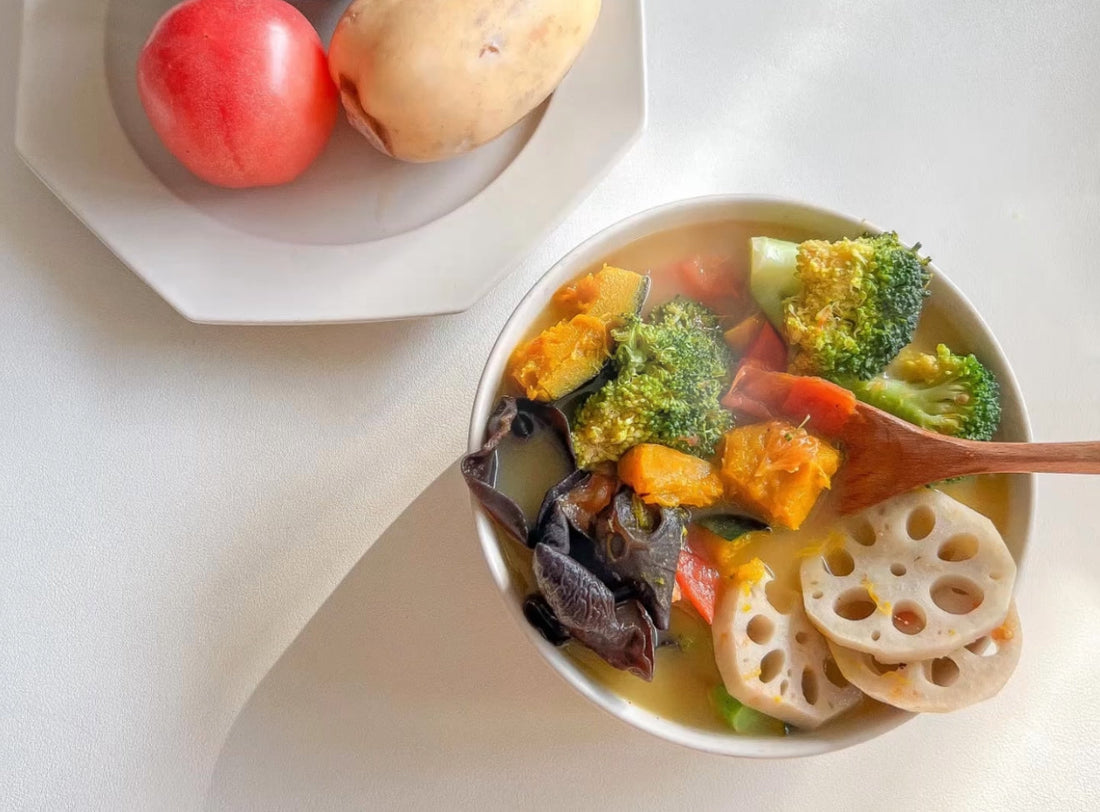
Comfort Meals: Nourishing the Body and Soul Across Cultures
Share
Comfort meals are more than just food—they are memories, medicine, and moments of care served in a bowl or on a plate.
In the United States and Europe, comfort meals often mean dishes that bring warmth and familiarity: a creamy bowl of mac and cheese, a slow-cooked beef stew, or a rustic loaf of bread with butter. Yet, if we look eastward, the idea of comfort meals deepens into an ancient philosophy where food is seen as medicine.
This article explores how comfort meals in the West can find new meaning through the lens of Chinese dietary therapy (食疗 Shíliáo), blending the wisdom of East and West to create a more balanced, mindful way of eating.

What Makes a Comfort Meal?
In the West, comfort meals are defined by warmth, familiarity, and a sense of home. They are dishes we crave when the weather turns cold or when life feels heavy. Think of chicken noodle soup on a sick day, or a hearty roast shared with family on a Sunday evening.
What these meals have in common is not complexity, but emotional connection. They soothe not only the stomach but also the mind. And this is exactly where they intersect with the Eastern tradition of dietary therapy—where food is prepared not only for taste but also for its effect on the body and spirit.
The Eastern Art of Balance in Comfort Meals
In Traditional Chinese Medicine (TCM), every food has an energetic property: warming, cooling, or neutral. The art of eating is about using these properties to balance your body in relation to the season and your personal state.
- Warming comfort meals: Ginger chicken soup, lamb stew, or baked root vegetables. These meals drive out cold and boost circulation, making them perfect for winter or for people who feel easily chilled.
- Cooling comfort meals: Cucumber salad, mung bean soup, or watermelon slices. These calm inflammation and help the body release excess heat, ideal for summer.
- Neutral comfort meals: Rice porridge, oats, or baked potatoes. These are safe staples, easy to digest, and grounding for everyone.
In this philosophy, a comfort meal is never just about taste—it is also about healing balance.
Comfort Meals in the U.S. and Europe: Hidden Healing Traditions
Even without the explicit framework of TCM, Western cultures have long practiced their own intuitive forms of dietary therapy.
- Chicken Soup in the U.S.: The classic “cure” for colds, made with onions, garlic, and broth. From a Chinese perspective, this is a warming, nourishing meal perfect for driving out cold and replenishing energy.
- Herbal Teas in Europe: Peppermint tea for digestion, chamomile tea for sleep, or elderflower tea for colds. These mirror the idea of selecting foods and herbs for their energetic properties.
- Hearty Stews and Breads: In Northern Europe, slow-cooked meats with root vegetables and rustic bread are winter staples. These are warming, grounding comfort meals that sustain energy in harsh weather.
The overlap shows that across cultures, people instinctively reach for foods that restore balance.

How to Create Comfort Meals with an Eastern Touch
1. Adapt to the Season
- Winter (Cold, Dry): Choose warming meals like stews, bone broth, or ginger tea.
- Summer (Hot, Humid): Refresh with cooling meals like mung bean soup, cucumber salad, or light tofu dishes.
2. Listen to Your Body
- If you feel fatigued: Add red dates and goji berries to your oatmeal or tea.
- If you feel bloated: Brew Pu-erh tea or try a simple barley porridge.
- If you feel feverish: Cool down with pears stewed in honey water.
3. Mix East and West in Your Kitchen
- A chicken noodle soup enriched with ginger and shiitake mushrooms.
- A barley risotto cooked with seasonal vegetables to drain summer dampness.
- A simple rice porridge, paired with roasted vegetables, balancing comfort with lightness.
Comfort Meals as a Path to Mindful Eating
Ultimately, the wisdom of both East and West reminds us: food is not just fuel, but connection.
When you choose a comfort meal, pause for a moment. Ask yourself:
- What does my body truly need right now?
- Am I cold, tired, restless, or overheated?
- What meal could balance me, not just satisfy my hunger?
This gentle awareness transforms eating into self-care. It shifts comfort meals from being about indulgence to being about nourishment and healing.
The Aurawell Philosophy
At Aurawell, we see this search for balance as a shared human aesthetic. From Chinese porridge pots to European herbal teas, the art of nourishment carries the same spirit across cultures.
Our vision is to bring this philosophy alive through language and product design—to merge traditions across oceans and let people everywhere experience healing not just in spirit, but also through beautiful, tangible creations.
That’s why our products, like the Mindful Candles, are crafted to embody the same harmony found in a comforting bowl of soup: warmth, beauty, and a sense of care.
Comfort Meals: Universal Healing
Whether it’s a bowl of porridge in Shanghai, a pot of stew in Berlin, or mac and cheese in an American kitchen, comfort meals tell the same story: they are medicine for the heart.
When East meets West, comfort meals become more than just food. They are living expressions of health, balance, and shared humanity.
So next time you prepare your favorite comfort dish, remember—you’re not only nourishing your body. You’re feeding your whole self.
